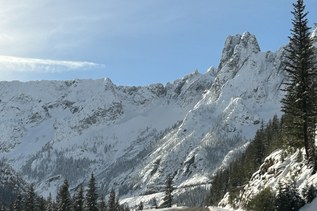Rising to a height of 7,000 feet, Goat Peak and its historic fire lookout comprise the most prominent landmark in the Methow Valley, visible from almost anywhere between Mazama and Winthrop. While the trail to its summit may inflict a little pain during its early steep stretches, you soon gain sweeping views from the floor of the valley to the tops of the airy summits of the North Cascades.
The trail begins in subalpine forest opening up to the occasional meadow of wildflowers. The trail follows a broad ridge, so every open space brings with it views to nearby peaks. In two thirds of a mile, you reach a steep section that is mercifully brief – after another two thirds of a mile and 800 vertical feet, attain a more pronounced ridge from which the lookout first comes into sight. From this vantage the lookout seems to tower over the Gardner Range to the south. A mostly level walk through windswept fields takes you to a final short climb. On the last turn before the summit, you’ll pass a massive cairn dedicated to the prior fire lookouts.
The summit is dominated, of course, by the lookout itself. While most of its brethren scattered across the state have long been rendered obsolete by observations from the air, it remains a working part of the forest fire detection system. For nineteen straight years, the lookout was staffed full-time during fire season by Bill Austin, who has developed a bit of a cult following as “Lightning Bill.” In 2014, the decision to staff the Leecher Lookout outside of Twisp moved him further down the valley. The Goat Peak lookout is now on call, staffed when approaching storms warrant an extra set of eyes.
As you would expect from a peak with a lookout, the views range far and wide. To the south, it looks as if you’re level with Gardner Mountain and North Gardner Mountain (even though they’re more than 1,000 feet taller). To the north, rolling ridges and the occasional sharper peak extend into the Pasayten Wilderness. Off to the southwest, Silver Star Mountain cracks a toothy, glaciated grin, yet another of the North Cascades’ taller peaks.
With so many geographic features containing the word “goat” within a stone’s throw of the trail (Goat Peak, Goat Creek, Goat Wall – even the town name of Mazama denotes a kind of goat), you might think time on the summit would be well spent looking for mountain goats; but a search of trip reports by WTA members over the past four years turns up no mention of them. There have supposedly been sporadic reports of goat sightings in and around the climbing routes of the nearby Goat Wall, but a search of reports from climbers also turns up nothing. Joan Burton’s 2006 book on hiking with kids in Western Washington mentions that the population of mountain goats here was, unfortunately, “slaughtered” in the 1920’s. If true, it’s a stunning reminder of the lasting impact such an action can have. On not-so-distant hikes like Blue Lake, mountain goats are common, and yet they still have not returned to this part of the valley, nearly a century later.
What Goat Peak lacks in wildlife, however, it makes up for in larches. In fall, it is one of the finest spots for viewing their golden hues. They grow here in several unusually dense groves on the western slopes along the top of the ridge, the first coming just a little over a mile from the trailhead.
Between the distant tall peaks and the nearby larches, Goat Peak puts much of what makes the North Cascades so incredible within easy reach. If you’re looking to introduce kids, family or non-hiking friends to the rewards of hiking, it is a supremely good place to visit.
Goat Peak Lookout

-
Length
- 3.7 miles, roundtrip
-
Elevation Gain
- 1,400 feet
-
Highest Point
- 7,001 feet
-
Calculated Difficulty
About Calculated Difficulty
- Moderate

 Full-size image
Full-size image
-
Fall foliage
-
Mountain views
-
Summits
-
Wildflowers/Meadows
Parking Pass/Entry Fee
Northwest Forest Pass
Views of majestic peaks and the vibrant golden hues of larches come autumn - Goat Peak Lookout offers both, as well as the commanding views you'd expect of a working fire lookout. Though steep at times, the trail's short length makes it a perfect hike to introduce kids and newer hikers to the grandeur of the Methow and North Cascades.
Continue reading 
Hiking Goat Peak Lookout
Hike Description Written by
Paul Kriloff,
WTA Correspondent
Map & Directions
 Trailhead
Trailhead
Before You Go
Parking Pass/Entry Fee
Northwest Forest PassWTA Pro Tip: Save a copy of our directions before you leave! App-based driving directions aren't always accurate and data connections may be unreliable as you drive to the trailhead.
Getting There
From the intersection with Lost River Road in Mazama, drive east on Goat Creek Road 1.8 miles to its junction with FS-52. Turn left onto FS-52 and follow it 2.6 miles to the junction with FS-5225. Turn left onto FS05225 and drive 6.2 miles to the junction with FS-200. Turn right and follow FS-200 2.9 miles to the trailhead and road end.
More Hike Details
Trailhead
North Cascades > Methow/Sawtooth
Goat Peak (#457)
Okanogan-Wenatchee National Forest, Methow Valley Ranger District
Guidebooks & Maps
Day Hiking: North Cascades (Romano - Mountaineers Books)
You can improve or add to this guidebook entry!





